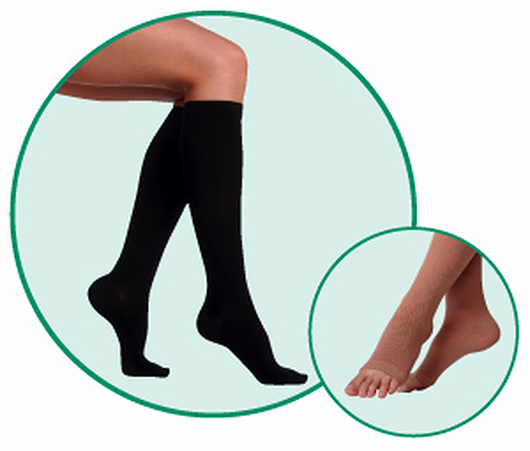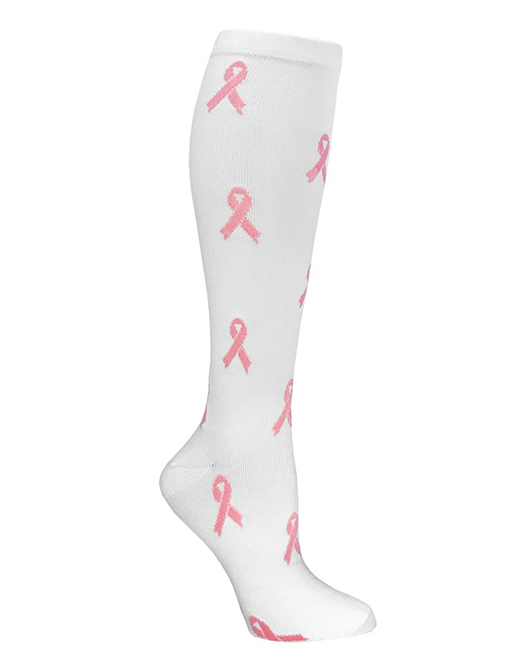Everything You Need to Know About Wearing Compression Socks
Oct 27th, 2020

Compression socks are an essential wardrobe addition for any patient recovering from breast cancer surgery. Removal of breast tissue or lymph nodes can put you at risk of developing lymphedema and infection. Compression socks enhance the circulation of blood and lymph for better comfort and faster healing.
But to get the most from your compression socks, it is crucial that you understand which style, type, and compression level are suitable for your needs. Here is everything you need to know about wearing compression socks.
Who are Compression Socks For?
Compression socks are beneficial to a variety of people for different health care reasons. Athletes wear them to accelerate muscle recovery and prevent injury. Anyone who may be on their feet for hours at a time, such as nurses and doctors, wear them to promote circulation and prevent their legs from feeling tired and heavy at the end of their shift.
For people recovering from breast cancer surgery, your doctor may have recommended compression socks to reduce the risk of lymphedema. Ultimately, compression socks are for anyone who needs to boost their circulation, including those at an increased risk for developing tissue swelling, blood clots, and varicose veins.
What are the Benefits of Compression Socks?
The benefits of wearing your compression socks are numerous, including:
- Preventing or minimizing fluid-build after surgery
- Speeding up the wound healing
- Lowering risk for developing Deep Vein Thrombosis (DVT)
- Alleviating discomfort from varicose veins and other leg conditions
- Reducing symptoms of Orthostatic Hypotension, a type of low blood pressure
- Enhancing comfort with gentle, consistent pressure
To learn more about many of these benefits, seek medical advice from your healthcare professional to be sure compression socks are recommended for your particular condition.
What Style of Compression Sock Should You Wear?
As with other types of socks, you have choices regarding the style of compression socks. The ones you choose often depend on what symptoms you are experiencing or trying to prevent. If all symptoms reside in the lower leg area, the knee-high style will suffice. If you wish to boost circulation higher into your things, try high stockings or pantyhose styles.
Whichever style you choose, they need to be fitted properly. If your compression socks are too loose, they won’t provide the right level of compression. Whereas extra tight compression socks can cut off your circulation, exacerbating symptoms.
To find the best fit, start by measuring your legs. Measure your ankle’s circumference, then your calf at its widest point if knee-highs are your choice. If you go with the higher thigh-high stocking type, also measure around your thigh at the highest point just under your buttocks, as well as the full length of your leg.

In addition, compression socks come in different designs and colors, like our Prestige 12” Compression Socks, which come in eight patterns, including the breast cancer awareness pink ribbon print.
You can also find compression dress socks to discreetly wear out in public and full compression tights for use under skirts and dresses. Footless calf sleeves and open-toed socks are other options that are ideal for warmer weather. Open-toed styles also reduce pressure on the feet, making them suitable for people with foot problems such as arthritis, gout, or bunions.
Juzo Soft Stockings come in both closed and open styles and multiple compression levels and lengths. The fine knit is discreet enough to wear under any outfit while still providing outstanding comfort and consistent pressure.
Choose the style that suits your lifestyle and therapeutic needs. Care for and maintain your garments properly with gentle hand washing to keep their compression longer.
What Types of Compression Socks Are Available?
Generally, there are two types of compression socks. The most common are graduated compression socks, which tightly apply pressure at the ankles and loosen up as they rise up the leg.
The second type is known as Anti-embolism stockings. This type is specifically designed to maintain blood flow to prevent the formation of blood clots, most often for those confined to the bed, such as after surgery.
What Compression Level is Best?
The levels of compression available range from mild to firm. The correct level for you will depend on your purpose for wearing them. The levels include:
- Mild compression (8-15 mmHg): suitable for light symptoms, fighting off fatigue, and maintaining on-going good leg health.
- Medium compression (15-20 mmHg): ideal for new wearers and those concerned with developing a DVT.
- Prescribed compression stockings are best for those with varicose veins, lymphedema, or on bed rest.
- Firm compression (20-30 mmHg)
- Extra Firm compression (30-40 mmHg)
- RX (40-50 mmHg)
When Do You Wear Compression Socks?
If your doctor prescribes you a pair of compression socks, you will be given guidelines for when to wear them. For leg swelling, you will usually pull the socks on early in the morning to prevent swelling from developing. You can also wear compression socks just during certain activities, such as working out. Most, however, can be worn all day.
Sleeping in compression socks is not advisable. Lying down affects your body’s circulation differently than when standing. The side effects of the pressure caused by the socks may have a negative impact on your circulation during the night.
Final Thoughts
Finding the right compression socks for your health needs can enhance your recovery from breast cancer surgery or alleviate discomfort from tired, heavy legs. At Mastectomyshop.com, we carry the best range of compression socks and garments available.



